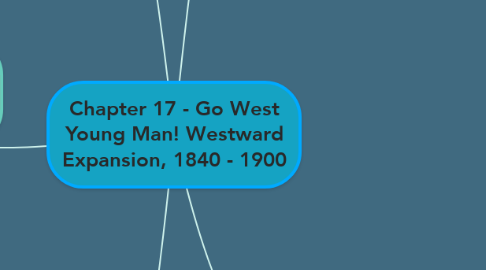
1. 17.3 Making a Living in Gold and Cattle
1.1. GOLD RUSH AND BEYOND
1.1.1. Some people traveling west wanted more than homestead farming, they were looking for a way to make a quick fortune
1.1.2. Gold was discovered at Sutter's Mill in Coloma, California
1.1.2.1. it did not take long for word to spread
1.1.3. the influx of people migrating west on a quest to mine gold for themselves became known as the Gold Rush
1.1.4. Many proved unsuccessful, however some did establish successful silver & copper mines
1.2. CATTLE KINGDOM
1.2.1. The completion of the first transcontinental railroad dramatically changed the cattle industry
1.2.1.1. cattle ranchers were able to round up and transport cattle for a significant profit - approx. $30 to $50 dollars per head
1.2.2. 1865 to 1885 - 40,000 cowboys roamed the Great Plains looking for work with local ranchers
1.2.3. The ranching industry was dangerous and lead to many conflicts with native tribes
1.2.4. 1873 - barbed wire was invented
1.3. WILD WEST
1.3.1. There is an element of truth to the violent myths of the wild west
1.3.2. most acts of violence happened in mining towns or on ranches
1.3.2.1. the west was poorly regulated and laws were difficult to enforce
1.3.3. the rough and violent culture did not begin to change until the 1880s as more families began to migrate
1.3.3.1. With a stronger family presence, schools, churches, and other community programs began to bring order to the wild west
2. 17.4 The Loss of American Indian Life and Culture
2.1. CLAIMING LAND, RELOCATING LANDOWNERS
2.1.1. Prior to the influx of western expansion, approx. 250,000 Indians from a variety of tribes populated the Great Plains
2.1.2. Americans migrating to the west first tried to peacefully negotiate with Indian tribes, however the approach did not last long
2.1.3. Settlers often resorted to violence when Indian tribes resisted negotiations
2.1.3.1. Dakota War
2.1.3.2. Sand Creek Massacre
2.1.3.3. Battle of Little Bighorn
2.2. AMERICANIZATION
2.2.1. assimilation of native americans
2.2.2. the government permitted reformers to remove Indian children from their homes and place them in boarding schools
2.2.3. land reform
2.2.3.1. Dawes Severalty Act of 1887
2.2.3.1.1. essentially an Indian version of the original Homestead Act
3. 17.5 The Impact of Expansion of Chinese Immigrants and Hispanic Citizens
3.1. CHINESE IMMIGRANTS IN THE AMERICAN WEST
3.1.1. Chinese immigrants began to arrive in the US in the 1820s
3.1.1.1. barley 650 living in the US by 1849
3.1.2. 1850
3.1.2.1. over 25,000
3.1.3. 1880
3.1.3.1. over 300,000
3.1.4. California
3.1.5. 1890
3.1.5.1. less than 5% of the Chinese population was female
3.1.6. most Chinese immigrants did not intend to stay in the US
3.1.7. prohibited by law to obtain citizenship through naturalization since 1790
3.1.7.1. harsh discrimination
3.1.7.1.1. special tax for Chinese miners during the Gold Rush
3.1.8. Chinese Exclusion Act of 1882
3.1.8.1. forbade further immigration for a ten year period
3.1.8.1.1. continued to be extended until its repeal
3.1.9. racism and discrimination became law
3.1.9.1. California Constitution of 1879
3.1.9.1.1. denied Chinese citizens the right to vote
3.1.9.1.2. denied state employment
3.2. HISPANIC AMERICAN IN THE AMERICAN WEST
3.2.1. Treaty of Guadalupe Hidalgo
3.2.1.1. ended the Mexican-American War in 1848
3.2.1.2. promised US citizenship to approx. 75,000 Hispanics in the American Southwest
3.2.1.2.1. approx. 90% accepted offer and chose to stay in the US
3.2.2. Hispanics were relegated to the worst-paying jobs
3.2.2.1. like the Chinese
3.2.3. massive influx of Anglo-American settlers
3.2.3.1. overran the Hispanic population
3.2.3.2. outnumbered
3.2.3.3. outvoted
3.2.3.4. outcast
4. 17.1 The Westward Spirit
4.1. MANIFEST DESTINY
4.1.1. The idea that Americans were destined to expand democratic institutions throughout the continent
4.1.1.1. Manifest Destiny justified in Americans' minds their right and duty to govern any other groups they encountered during their expansion
4.1.1.1.1. Americans began to move westwards, the most famous route was known as the Oregon Trial
4.2. FEDERAL GOVERNMENT ASSISTANCE
4.2.1. The government assisted settlers in their move westward with the Homestead Act
4.2.1.1. Homestead Act
4.2.1.1.1. gave a parcel of 160 acres for a minimal fee
4.2.1.1.2. over 270 million acres of land was given to private citizens
4.2.1.2. Pacific Railway Act
4.2.1.2.1. commissioned the Union Pacific Railroad to make new railroads throughout the west
4.3. WHO WERE THE SETTLERS?
4.3.1. 1840s to 1850s
4.3.1.1. settlers were mostly white native-born farming families
4.3.2. 1870s
4.3.2.1. the Homestead Act allowed people from a variety of backgrounds to migrate west
4.3.3. German, Scandinavian, and Irish immigrants were the most common
4.3.4. Approx. 200,000 Chinese immigrants migrated to California from 1876 to 1890
4.3.5. American Americans migrated west to escape the racist South, they were commonly known as "Exodusters"
5. 17.2 Homesteading: Dream and Realities
5.1. THE DIFFICULT LIFE OF THE PIONEER FARMER
5.1.1. settlement challenges west of the Mississippi River
5.1.1.1. land was difficult to farm
5.1.1.2. harsh weather
5.1.1.3. minimal building materials
5.1.1.4. lack of medical knowledge/very few doctors
5.1.1.5. Railroad costs
5.1.1.5.1. rise of industrialization
5.1.1.5.2. expensive to ship crops
5.1.2. sod houses
5.1.2.1. the first houses built by western settlers
5.1.2.2. usually made out of mud, sod, and had thatch roofs
5.1.2.3. minimal timber for use
5.1.3. finances
5.1.3.1. threat of debt
5.1.3.1.1. the Homestead Act gave free land, but did not pay for all other farm necessities
5.1.3.2. bank foreclosure
5.1.3.3. bonanza farms
5.1.3.3.1. larger commercial farms
5.1.3.3.2. most settlers became migrant farmers
5.2. PIONEER WIFE
5.2.1. childbirth
5.2.1.1. usually no doctor or midwife
5.2.2. reinforced domestic lifestyle and traditional western society gender roles
5.2.3. positives
5.2.3.1. women did manage to break through some legal and social barriers
5.2.3.1.1. usually worked as equals
5.2.3.1.2. if widowed, the wife typically took over the farm (rare for women to have that much managerial power)
5.2.3.1.3. most of the first states to advocate for women's rights were those in the Pacific NW and Upper MW
